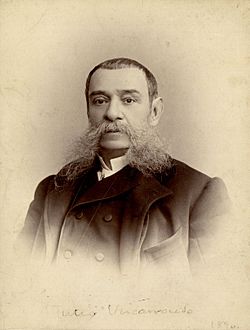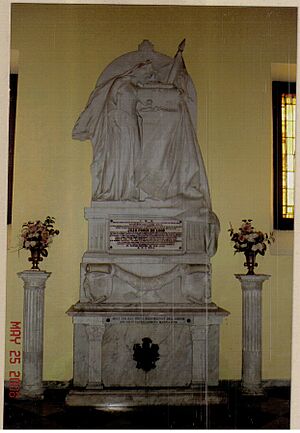Julio Vizcarrondo facts for kids
Quick facts for kids
Julio Vizcarrondo Coronado
|
|
|---|---|

Julio Vizcarrondo Coronado
|
|
| Born | December 9, 1829 |
| Died | 1889 |
| Nationality | Puerto Rican |
| Occupation | Journalist, Political activist |
| Notes | |
|
Vizcarrondo Coronado was founder of the Protestant movement in the Iberian Peninsula in the 19th century
|
|
Julio Vizcarrondo Coronado (December 9, 1829 – 1889) was an important Puerto Rican leader. He was a journalist, a politician, and a religious figure who worked hard to end slavery and bring about positive changes. He played a key role in creating the Moret Law in 1873, which officially ended slavery in Puerto Rico. Vizcarrondo also helped start the Protestant movement in Spain and Portugal during the 1800s.
Contents
Who Was Julio Vizcarrondo Coronado?
Julio Vizcarrondo Coronado was born in San Juan, Puerto Rico, on December 9, 1829. His parents were Dr. Jose Bonifacio Vizcarrondo y Ortiz de Zarate and María Josefa Coronado y Martínez. His family owned a large farm, called a Hacienda, where enslaved people worked. Julio went to school in Puerto Rico's capital city. Later, he continued his studies in Madrid, Spain, and Paris, France.
A Voice for Freedom: Journalism
When Julio Vizcarrondo returned to Puerto Rico, he started writing for a local newspaper. He shared his ideas about freedom and strongly spoke out against slavery. The Spanish government, which ruled Puerto Rico at the time, did not like his views. The governor of the island, Juan de la Pezuela y Cevallos, ordered him to leave and go to the United States.
Exile and His Return Home
In 1850, Vizcarrondo arrived in New York City. There, he joined an important group called the "International Conference of Paris against Slavery." He became a secretary for this group, working to end slavery around the world. In New York, he met and married Henriette Brewster y Cornell. He also became a Protestant, which was his wife's faith.
In 1854, Vizcarrondo came back to Puerto Rico. He continued to write articles and share his ideas. He took a big step by freeing the enslaved people his family owned. He then became a strong supporter of the rights of all enslaved Black people in Puerto Rico. He often went to court to report slave owners who treated their slaves badly. This made him many enemies. Vizcarrondo also spoke out against what he saw as unfair treatment of Puerto Ricans by the Spanish government.
Helping Children and Preserving History
In 1857, he started his own newspaper called El Mercurio (The Mercury). He also created "La Casa de la Caridad de San Ildefonso," which was a school. This school offered free education to children whose families had little money. His wife was the principal of this special school.

In 1863, Vizcarrondo was chosen to help move the remains of Juan Ponce de León. Ponce de León was an important historical figure, and his remains were moved from the Church of San José to the Cathedral of San Juan Bautista. Vizcarrondo kept expressing his ideas in his newspaper, which continued to create disagreements with those who held different views.
He wrote several educational books on math, history, and geography for his school. In 1866, he also wrote a spelling book called El Silabario Puertorriqueño (The Puerto Rican Primary Textbook). This book used older methods to help children learn to read and was used in schools across the island. He also published Elementos de Historia y Geografía de Puerto Rico (The Elements of History and Geography of Puerto Rico), which became a textbook.
Making a Difference in Spain
In 1863, Vizcarrondo moved to Madrid, Spain. There, he joined other people from Puerto Rico and Cuba who also wanted to end slavery. While he was in Spain, a serious illness called cholera spread. Vizcarrondo and his friends started an organization called "Sociedad de Amigos de los Pobres" (The Society of the Friends of the Poor). This group helped people who were most affected by the illness by rescuing them, providing food, and offering assistance. He even opened his own home as a temporary hospital. The Spanish government gave him a medal for his brave actions during this time. Later, he helped create the "Hospital del Niño Jesús” (Baby Jesus Hospital).
Vizcarrondo is also known for helping to start the Protestant movement in Spain and Portugal in the 1800s. He was the president of the Central Committee of the Spanish Evangelical Union. He worked hard to establish a Protestant church in Madrid. Even though it was difficult, on January 24, 1869, he convinced the mayor of Madrid to allow Protestants to hold their religious services in public.
A Champion for Change: Political Work
Vizcarrondo joined the Spanish Republican Party. He played a role in preparing for the Liberal Revolution as a secretary for the revolutionary committee in Madrid. When the government found out about his involvement, he was sent away to France. However, he returned to Spain soon after the revolution succeeded. He again took a position in the revolutionary committee of Madrid. He also helped to restart the Abolitionist Society.
The Fight to End Slavery
In 1873, Vizcarrondo worked with other important figures like Ramon Baldorioty de Castro, Luis Padial, and the Minister of Overseas Affairs, Segismundo Moret. Together, they proposed a law to end slavery in Puerto Rico and Cuba. On March 22, 1873, the Spanish Government approved their idea. This became known as the Moret Law, which was a huge step towards freedom.
Working for Puerto Rico's Future
On May 1, 1880, Vizcarrondo and Rafael María de Labra founded the Sociedad Nacional Democrática (National Democratic Society). This political party aimed to gain more self-governance, or "autonomy," for both Puerto Rico and Cuba. Autonomy means having more control over their own affairs.
In 1886, he was elected to represent the district of Ponce in the Cortes in Madrid. The Cortes was like the Spanish Parliament. He held this position until he passed away in 1889. In the Spanish Parliament, Vizcarrondo suggested that Puerto Rico should have a similar type of autonomy to what Canada had at that time. In 1887, he was part of a large effort against the Spanish governor of Puerto Rico, Romualdo Palacio González. This campaign led to the governor being replaced.
Lasting Impact and Legacy
Julio Vizcarrondo Coronado died in 1889, in Madrid. His memory is honored in Puerto Rico, where schools in the towns of Carolina and Cayey are named after him. He is remembered as a dedicated journalist, educator, and politician who fought tirelessly for freedom and justice.
See also
 In Spanish: Julio Vizcarrondo para niños
In Spanish: Julio Vizcarrondo para niños

